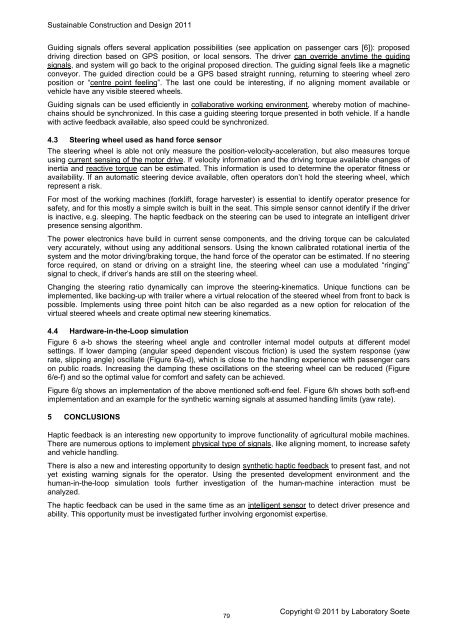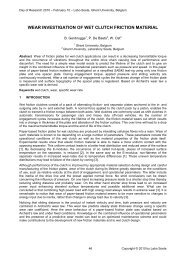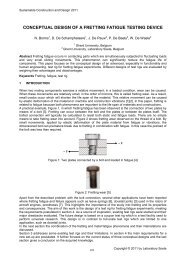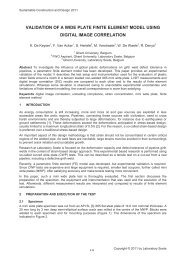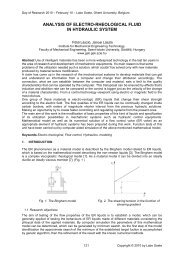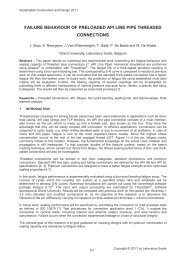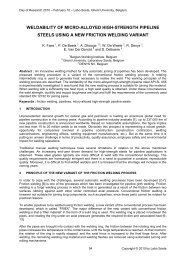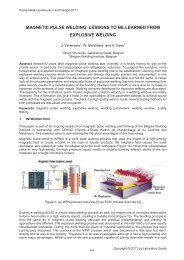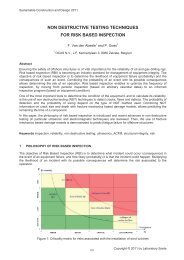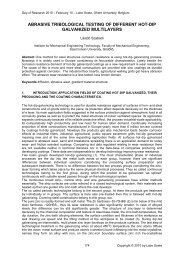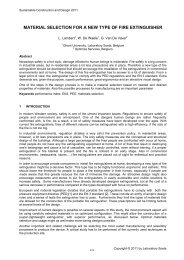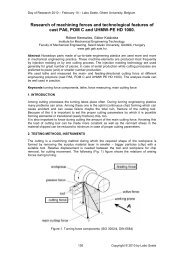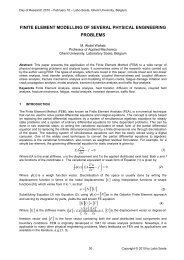Volume 2, Issue 1, 2011, Full Text - 5th International Conference on ...
Volume 2, Issue 1, 2011, Full Text - 5th International Conference on ...
Volume 2, Issue 1, 2011, Full Text - 5th International Conference on ...
Create successful ePaper yourself
Turn your PDF publications into a flip-book with our unique Google optimized e-Paper software.
Sustainable C<strong>on</strong>structi<strong>on</strong> and Design <str<strong>on</strong>g>2011</str<strong>on</strong>g><br />
Guiding signals offers several applicati<strong>on</strong> possibilities (see applicati<strong>on</strong> <strong>on</strong> passenger cars [6]): proposed<br />
driving directi<strong>on</strong> based <strong>on</strong> GPS positi<strong>on</strong>, or local sensors. The driver can override anytime the guiding<br />
signals, and system will go back to the original proposed directi<strong>on</strong>. The guiding signal feels like a magnetic<br />
c<strong>on</strong>veyor. The guided directi<strong>on</strong> could be a GPS based straight running, returning to steering wheel zero<br />
positi<strong>on</strong> or “centre point feeling”. The last <strong>on</strong>e could be interesting, if no aligning moment available or<br />
vehicle have any visible steered wheels.<br />
Guiding signals can be used efficiently in collaborative working envir<strong>on</strong>ment, whereby moti<strong>on</strong> of machinechains<br />
should be synchr<strong>on</strong>ized. In this case a guiding steering torque presented in both vehicle. If a handle<br />
with active feedback available, also speed could be synchr<strong>on</strong>ized.<br />
4.3 Steering wheel used as hand force sensor<br />
The steering wheel is able not <strong>on</strong>ly measure the positi<strong>on</strong>-velocity-accelerati<strong>on</strong>, but also measures torque<br />
using current sensing of the motor drive. If velocity informati<strong>on</strong> and the driving torque available changes of<br />
inertia and reactive torque can be estimated. This informati<strong>on</strong> is used to determine the operator fitness or<br />
availability. If an automatic steering device available, often operators d<strong>on</strong>’t hold the steering wheel, which<br />
represent a risk.<br />
For most of the working machines (forklift, forage harvester) is essential to identify operator presence for<br />
safety, and for this mostly a simple switch is built in the seat. This simple sensor cannot identify if the driver<br />
is inactive, e.g. sleeping. The haptic feedback <strong>on</strong> the steering can be used to integrate an intelligent driver<br />
presence sensing algorithm.<br />
The power electr<strong>on</strong>ics have build in current sense comp<strong>on</strong>ents, and the driving torque can be calculated<br />
very accurately, without using any additi<strong>on</strong>al sensors. Using the known calibrated rotati<strong>on</strong>al inertia of the<br />
system and the motor driving/braking torque, the hand force of the operator can be estimated. If no steering<br />
force required, <strong>on</strong> stand or driving <strong>on</strong> a straight line, the steering wheel can use a modulated “ringing”<br />
signal to check, if driver’s hands are still <strong>on</strong> the steering wheel.<br />
Changing the steering ratio dynamically can improve the steering-kinematics. Unique functi<strong>on</strong>s can be<br />
implemented, like backing-up with trailer where a virtual relocati<strong>on</strong> of the steered wheel from fr<strong>on</strong>t to back is<br />
possible. Implements using three point hitch can be also regarded as a new opti<strong>on</strong> for relocati<strong>on</strong> of the<br />
virtual steered wheels and create optimal new steering kinematics.<br />
4.4 Hardware-in-the-Loop simulati<strong>on</strong><br />
Figure 6 a-b shows the steering wheel angle and c<strong>on</strong>troller internal model outputs at different model<br />
settings. If lower damping (angular speed dependent viscous fricti<strong>on</strong>) is used the system resp<strong>on</strong>se (yaw<br />
rate, slipping angle) oscillate (Figure 6/a-d), which is close to the handling experience with passenger cars<br />
<strong>on</strong> public roads. Increasing the damping these oscillati<strong>on</strong>s <strong>on</strong> the steering wheel can be reduced (Figure<br />
6/e-f) and so the optimal value for comfort and safety can be achieved.<br />
Figure 6/g shows an implementati<strong>on</strong> of the above menti<strong>on</strong>ed soft-end feel. Figure 6/h shows both soft-end<br />
implementati<strong>on</strong> and an example for the synthetic warning signals at assumed handling limits (yaw rate).<br />
5 CONCLUSIONS<br />
Haptic feedback is an interesting new opportunity to improve functi<strong>on</strong>ality of agricultural mobile machines.<br />
There are numerous opti<strong>on</strong>s to implement physical type of signals, like aligning moment, to increase safety<br />
and vehicle handling.<br />
There is also a new and interesting opportunity to design synthetic haptic feedback to present fast, and not<br />
yet existing warning signals for the operator. Using the presented development envir<strong>on</strong>ment and the<br />
human-in-the-loop simulati<strong>on</strong> tools further investigati<strong>on</strong> of the human-machine interacti<strong>on</strong> must be<br />
analyzed.<br />
The haptic feedback can be used in the same time as an intelligent sensor to detect driver presence and<br />
ability. This opportunity must be investigated further involving erg<strong>on</strong>omist expertise.<br />
79<br />
Copyright © <str<strong>on</strong>g>2011</str<strong>on</strong>g> by Laboratory Soete


